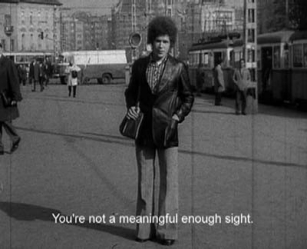Self-Fashion Show, a short film made by the Hungarian artist Tibor Hajas (1946–1980) at the Balázs Béla Studio in 1976, takes as its subject a busy Budapest street and especially the passersby on it. Hajas asks them to stand in front of the camera and pose in front of it silently. For part of the film, this happens right in the midst of pedestrian traffic, so that as viewers, we are aware of our own gaze as we see other people on the street observe the proceedings with emotions ranging from suspicion to indifference and bemusement. For much of the film, however, the passersby selected for filming stand in front of a makeshift backdrop, which, we realize toward of the end of the film, is found not in a studio but also right in the middle of the street. The footage of people in front of the backdrop completely separates people from their environment and highlights the awkwardness most appear to feel at being on camera.
Banner stills L to R: Litany of Happy People, courtesy Slovene Cinematheque;
Death of Metalosaurus, courtesy Igor Toholj; and Game, courtesy Slovene Cinematheque
Self-Fashion Show (Öndivatbemutató)
Tibor Hajas, Hungary, 1976, 35 mm transfer to digiBeta, 14 minutes 41 seconds

Still from Self-Fashion Show, courtesy MaNDA Archive
At the same time, the sound track of the film consists of directions and comments that a to be directed at the people posing but were, in fact, recorded separately by Hajas in the studio (much like the dialogues in Tamas St. Auby’s Centaur). Some remarks are reassuring or neutral, whereas others are intimidating and suggest an interrogation, for example, “You aren’t forced to say anything that you’d feel sorry for later on.” The voices seem to represent either the subjects’ imagined internal monologue or, perhaps more likely, given Hajas’ history of run-ins with Communist authorities, external voices of authority of which, the film suggest, the subjects are aware at all times. As Helena Holmberg writes, “The ‘models’ who cannot hear the voices still seem to be cowering before the criticism. They are being inspected, subjected to the scrutinizing gaze of the camera and their language has been taken away from them.” Indeed, the voiceover has an echo in a 1975 work by the Serbian composer and artist Vladan Radovanović, who made “a recording at Radio Belgrade’s Electronic Studio that was later released as a 45 rpm ‘single.’” Entitled Voice from the Loudspeaker (Glas iz zvuč nika), it speaks directly to the listener, ominously opening with, “‘Each of you can hear me. / This voice is in each of you. / This voice is in the loudspeaker. / This voice has nothing to do with the loudspeaker.’”[1]

Still from Self-Fashion Show, courtesy MaNDA Archive
For art historian László Beke, Self-Fashion Show is a comment on “how one can manipulate documentary material, [that is,] the truth of everyday reality” through the introduction of the film camera, which had been understood by such avant-garde film theorists as Dziga Vertov as the tool most fit to capture truth.[2]. In Hajas’ film, it seems self-evident that the presence of the camera and the knowledge of being watched inform and alter how the subjects fashion themselves, thus changing the truth that the filmmakers first encountered. This truth, moreover, changes in unpredictable ways: although some subjects seem uncomfortable or even cowed by the camera, others enact defiance or coolness that may not have been there before. In the meantime, as another observer notes, “the vulnerability and manipulability” of all the people whom the camera approached “are highlighted by the soundtrack added later.”
The body of work that Hajas completed before his death in a car accident at age 34 ranged widely in media but was, as John P. Jacob writes, consistently preoccupied with challenging audiences and himself “against the danger of moral and intellectual passivity.” In Hajas’ most extreme works, such as Dark Flash, the artist thrust the responsibility to act rather than remain passive onto his audience in a very immediate way. In this performance, “held at the Galeria Remont in Warsaw, 1978, Hajas hung from the ceiling by a rope bound to his wrists. In his hands he held a camera. As the blood drained from his hands and cut off his circulation, Hajas photographed his audience until, at last, he passed out. Had his audience not finally cut him down, the artist might have died. His film documents their indecision.” Self-Fashion Show, by comparison, is a much more meditative work, but it, too, considers forces—such as surveillance and public scrutiny—that might encourage passivity and by using everyday citizens as its subjects suggests that the topic has universal applicability. — Ksenya Gurshtein
The organizers would like to thank Dr. Walter Seidl and Hephzibah Druml at Kontakt: The Art Collection of Erste Group and ERSTE Foundation and Sebestyén Kodolányi, Balázs Béla Stúdió Archive, for their assistance in the research of this film. With thanks also to Dorottya Szörényi and the Hungarian National Digital Archive and Film Institute (Magyar Nemzeti Digitális Archívum és Filmintézet [MaNDA]) for their help in making a screening of this film possible in Washington.
1. David Crowley and Daniel Muzyczuk, Sounding the Body Electric, exh. cat. (Łódź, 2012), 87. (back to top)
2. László Beke, “Hungarian Experimental Film and the Béla Balázs Studio,” in BBS Budapest: Twenty Years of Hungarian Experimental Film (New York, 1985), 8. (back to top)
